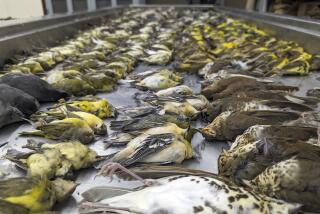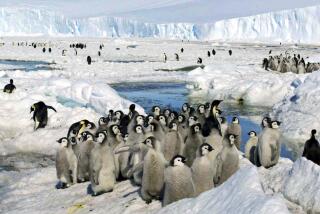Tale of passenger pigeon extinction may have had natural twist
- Share via
One hundred years ago in September, Martha the passenger pigeon died in a Cincinnati zoo.
She was the last of a North American species whose population once had numbered in the billions. Naturalist John James Audubon once described a mile-wide migratory flock that darkened the Kentucky skies for days in 1813 -- and brought the Louisville population to the banks of the Ohio River with their guns.
Even discounting for artistic license, that’s a lot of birds.
The extinction of Ectopistes migratorius, punctuated by Martha’s demise, has become a lesson taught in generations of ecology courses about what happens when humans over-hunt animals and destroy their habitat.
The full story, however, may be more complicated, according to researchers in Taiwan. They suggest that the pigeon population was prone to wild fluctuations over thousands of years, and that ecological cycles could have contributed to a “perfect storm” of human and natural pressure to drive the species over the brink within five decades.
The researchers came to that conclusion (published online Monday in the journal Proceedings of the National Academy of Sciences) by extracting ancient DNA from the toe pads of four preserved passengers pigeons and sequencing their genome.
The genome data helped the researchers calculate the genetically effective population size of the pigeon over the last million years. That’s a measure of how many individuals would have been required to produce the diversity seen in the genome. It’s a hypothetical benchmark that assumes conditions seldom met by nature. But wildlife biologists have found that the ratio of the genetically effective population to a census-based population usually hovers around 1/10.
The ratio for the passenger pigeon was on the order of 1/100 or 1/1,000, the researchers found. That was a tell-tale sign that population had crashed and recovered, the researchers concluded. The passenger pigeon was an “outbreak” species, like locusts.
Passenger pigeons were rather odd avians. They could fly incredibly fast, out-maneuver aerial opponents and cover great distances. But their survival strategy appears to have been based on safety in numbers, according to previous research.
Producing just one chick per mating, the pigeons shoved their young squabs from the nest to the forest floor, where foxes, wolves, snakes and other predators feasted on them. But the predators couldn’t eat all of the squabs, and the pigeons also would go somewhere else the next season.
Those habits also stripped forests of food, damaged trees and left a noxious blanket of droppings on forest floors, the authors noted.
The authors wondered how climate and food might have affected the pigeon population. They created ecological niche models, and found that breeding territory changed drastically with long-term glacial cycles.
A shorter range analysis of fossil oak pollen confirmed that there would have been sufficient food to support the number of birds reported in the historical record. But it also revealed sharp year-to-year changes in acorn production that could have affected the birds, according to the study.
The passenger pigeon population probably swelled, crashed and recovered cyclically over the last million years, based on climate, food and other factors, the authors said. By the late 1800s, the bird population may have been in a down cycle that was exacerbated by over-hunting and land clearing. The population fell below historic thresholds for recovery, eventually leaving the one lonely Cincinnati pigeon named for Martha Washington.
“We don’t have evidence; it’s a hypothesis,” said the study’s lead author, Chih-Ming Hung, an evolutionary ecologist at the National Taiwan Normal University in Taipei. “We think if this [cycle] is what really happened, it would explain why the passenger pigeon went extinct so rapidly.”
The researchers believe a similar analysis could help explain the abrupt extinction of the Rocky Mountain grasshopper at the end of the 19th century. Leading theories suggest that cattle pasturing and mining, which tore up the insects’ nesting ecosystem in river valleys of the northern Rocky Mountains, coincided with a down cycle in the grasshopper population.
While scientists preserved dead specimens of the passenger pigeon, such care wasn’t taken with the grasshopper, whose demise wasn’t exactly mourned. So, the Taiwan team has no plans to seek quality grasshopper DNA.
Besides, said Hung, “we are mainly ornithologists; We are not entomologists.”







